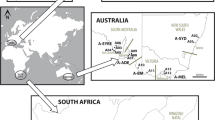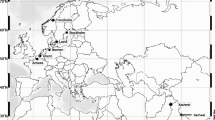Abstract
We found a new non-native haplotype of Phragmites australis in North America that provides convincing evidence for multiple introductions of this highly invasive reed from Europe. Prior to our detection of this new non-native haplotype, invasion of North America by this reed grass was thought to be limited to a single cp-DNA haplotype–haplotype M. However, we found two sites colonized by haplotype L1 in Quebec, Canada, a haplotype native to northern Europe, Great Britain and Romania. Because the invasion of North America by P. australis is ongoing, and because there is evidence for intra- and inter-specific hybridization and increased fecundity resulting from outcrossing, more attention should be paid to genetic differences and associated vigor of populations of introduced Phragmites across North America.
Similar content being viewed by others
References
Chambers RM, Meyerson LA, Saltonstall K (1999) Expansion of reed into tidal wetlands of North America. Aquat Bot 64:261–273
Chambers RM, Meyerson LA, Lellis-Dibble K (2012) Ecology of Phragmites and response to tidal restoration. In: Roman C, Burdick D (eds) Restoring tidal flow to salt marshes: a synthesis of science and management in New England, Island Press, pp 81–96
Ellstrand NC, Schierenbeck KA (2000) Hybridization as a stimulus for the evolution of invasiveness in plant? Proc Natl Acad Sci USA 97:7043–7050
Freeland J, Vachon N (2012) Repetitive sequences in phylogeographic inference: a reply to Saltonstall and Lambertini (2012). Mol Eco Resour 12:586–589
Hall TA (1999) BioEdit: a user-friendly biological sequence alignment editor and analysis program for Windows 95/98/NT. Nucl Acids Symp Ser 41:95–98
Hauber DP, Saltonstall K, White DA, Hood CS (2011) Genetic variation in the common reed, Phragmites australis, in the Mississippi River Delta marshes: evidence for multiple introductions. Estuaries Coasts 34:851–862
Howard R, Travis JSE, Stiles BA (2008) Rapid growth of a Eurasian haplotype of Phragmites australis in a restored brackish marsh in Louisiana, USA. Biol Invasions 10:369–379
Kirk H, Paul J, Straka J, Freeland JR (2011) Long-distance dispersal and high genetic diversity are implicated in the invasive spread of the common reed, Phragmites australis (Poaceae), in northeastern North America. Am J Bot 98(7):1180–1190
Lambertini C, Mendelssohn I, Gustafsson MGH, Olesen B, Riis T, Sorrell BK, Brix H (2012a) Tracing the origin of Gulf Coast Phragmites (Poaceae)—a story of long distance dispersal and hybridization. Am J Bot. doi:10.3732/ajb.1100396
Lambertini C, Sorrell BK, Riss T, Olesen B, Brix H (2012b) Exploring the borders of European Phragmites australis within a cosmopolitan genus. AoB Plants. doi:10.1093/aobpla/pls020
Lockwood JL, Cassey P, Blackburn T (2005) The role of propagule pressure in explaining species invasions. Trends Ecol Evol 20:223–228
McCormick MK, Kettenring KM, Baron HM, Whigham DF (2010) Spread of invasive Phragmites australis in estuaries with differing degrees of development: genetic patterns, Allee effects and interpretation. J Ecol 98:1369–1378
Meyerson LA, Viola D, Brown RN (2010a) Hybridization of invasive Phragmites australis with a native subspecies in North America. Biol Invasions 12:103–111
Meyerson LA, Lambert A, Saltonstall K (2010b) A tale of three lineages: expansion of common reed (Phragmites australis) in the US Southwest and Gulf Coast. Invasive Plant Sci Manag 3:489–494
Meyerson LA, Lambertini C, McCormick M, Whigham D (2012) Hybridization of common reed in North America? The answer is blowing in the wind. AoB Plants. doi:10.1093/aobpla/pls022
Paul J, Vachon N, Garroway CJ, Freeland JR (2010) Molecular data provide strong evidence of natural hybridization between native and introduced lineages of Phragmites australis in North America. Biol Invasions 12:2967–2973
Plut K, Paul J, Ciotir C, Major M, Freeland JR (2011) Origin of non-native Phragmites australis in North America, a common wetland invader. Fundam Appl Limnol 179:121–129
Roman J (2006) Diluting the founder effect: cryptic invasions expand a marine invaders range. Proc Roy Soc B 273:2453–2459
Saltonstall K (2002) Cryptic invasion by a non-native genotype of the common reed, Phragmites australis, into North America. Proc Natl Acad Sci USA 99:2445–2449
Saltonstall K (2003) Microsatellite variation within and among North American lineages of Phragmites australis. Mol Ecol 12: 1689–1702
Saltonstall K, Lambert A, Meyerson LA (2010) Genetics and reproduction of common (Phragmites australis) and Giant Reed (Arundo donax). Invasive Plant Sci Manag 3:495–505
Saltonstall K, Lambertini C (2012) The value of repetitive sequences in chloroplast DNA for phylogeographic inference: a comment on Vachon and Freeland 2011. Mol Ecol Res 12:581–585
Schierenbeck KA, Ellstrand NC (2009) Hybridization and the evolution of invasiveness in plants and other organisms. Biol Invasions 11:1093–1105
Simberloff D (2009) The role of propagule pressure in biological invasions. Annu Rev Ecol Evol Syst 40:81–102
Swearingen J, Saltonstall K (2010) phragmites field guide: distinguishing native and exotic forms of common reed (Phragmites australis) in the United States. Plant conservation alliance, weeds gone wild. http://www.nps.gov/plants/alien/pubs/index.htm
Vachon N, Freeland JR (2011) Phylogeographic inferences from chloroplast DNA: quantifying the effects of mutations in repetitive and non-repetitive sequences. Mol Ecol Resour 11:279–285
Acknowledgments
We thank Jacques Brisson, Sylvie de Blois and Claude Lavoie for their assistance in locating field sites. We thank Carla Lambertini for sharing her data and for helpful comments on this manuscript. We thank the reviewer, Steve Keller and Fred Meyerson for comments on this manuscript. Funding was provided to LAM and JTC by the US National Science Foundation DEB Awards 1049914 and 1050084. Additional funding to LAM was provided by the Fulbright Commission of the United States and the Czech Republic, and the University of Rhode Island College of Environment and Life Sciences Agricultural Experiment Station Project RI00H-332, 311000-6044.
Author information
Authors and Affiliations
Corresponding author
Rights and permissions
About this article
Cite this article
Meyerson, L.A., Cronin, J.T. Evidence for multiple introductions of Phragmites australis to North America: detection of a new non-native haplotype. Biol Invasions 15, 2605–2608 (2013). https://doi.org/10.1007/s10530-013-0491-2
Received:
Accepted:
Published:
Issue Date:
DOI: https://doi.org/10.1007/s10530-013-0491-2




